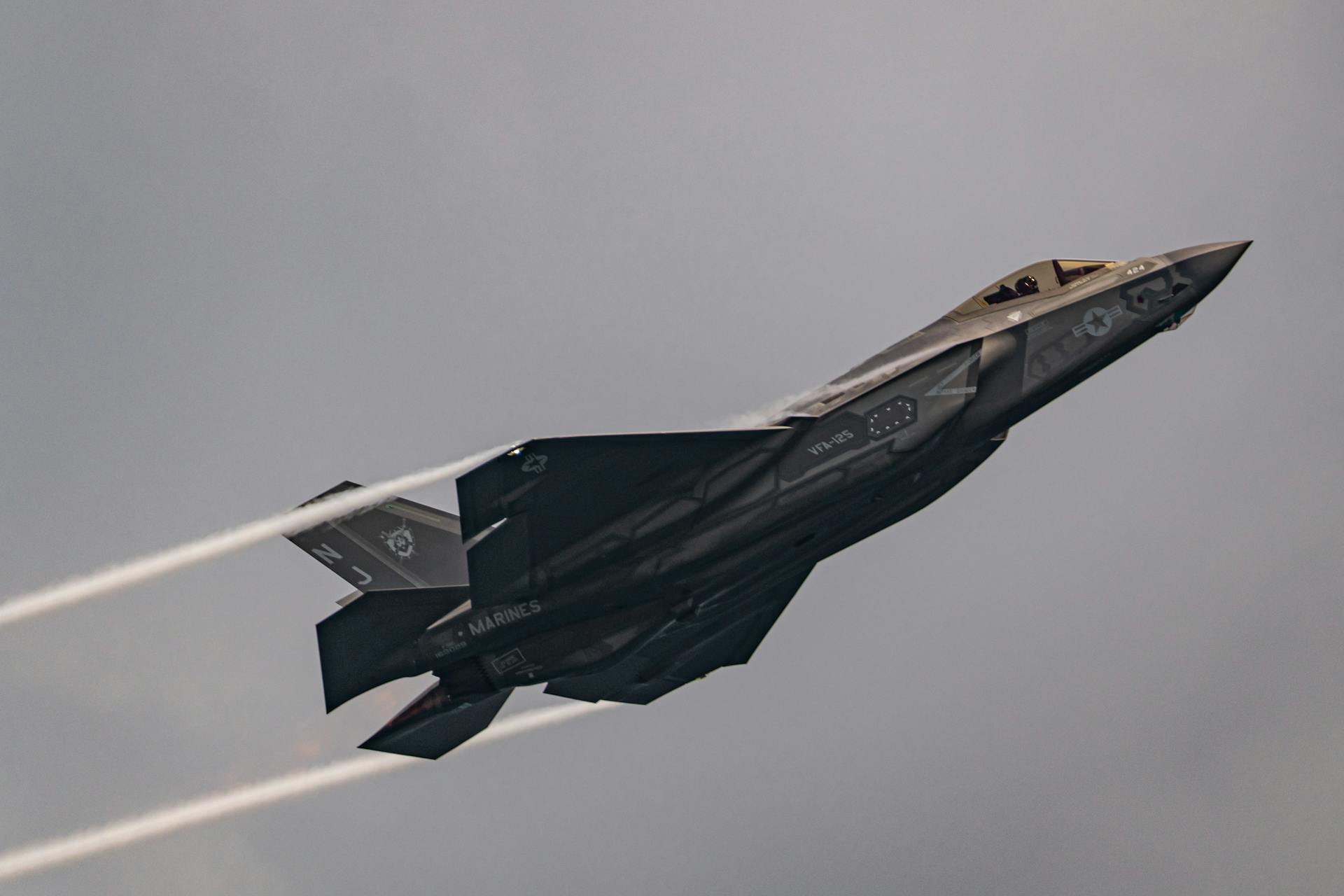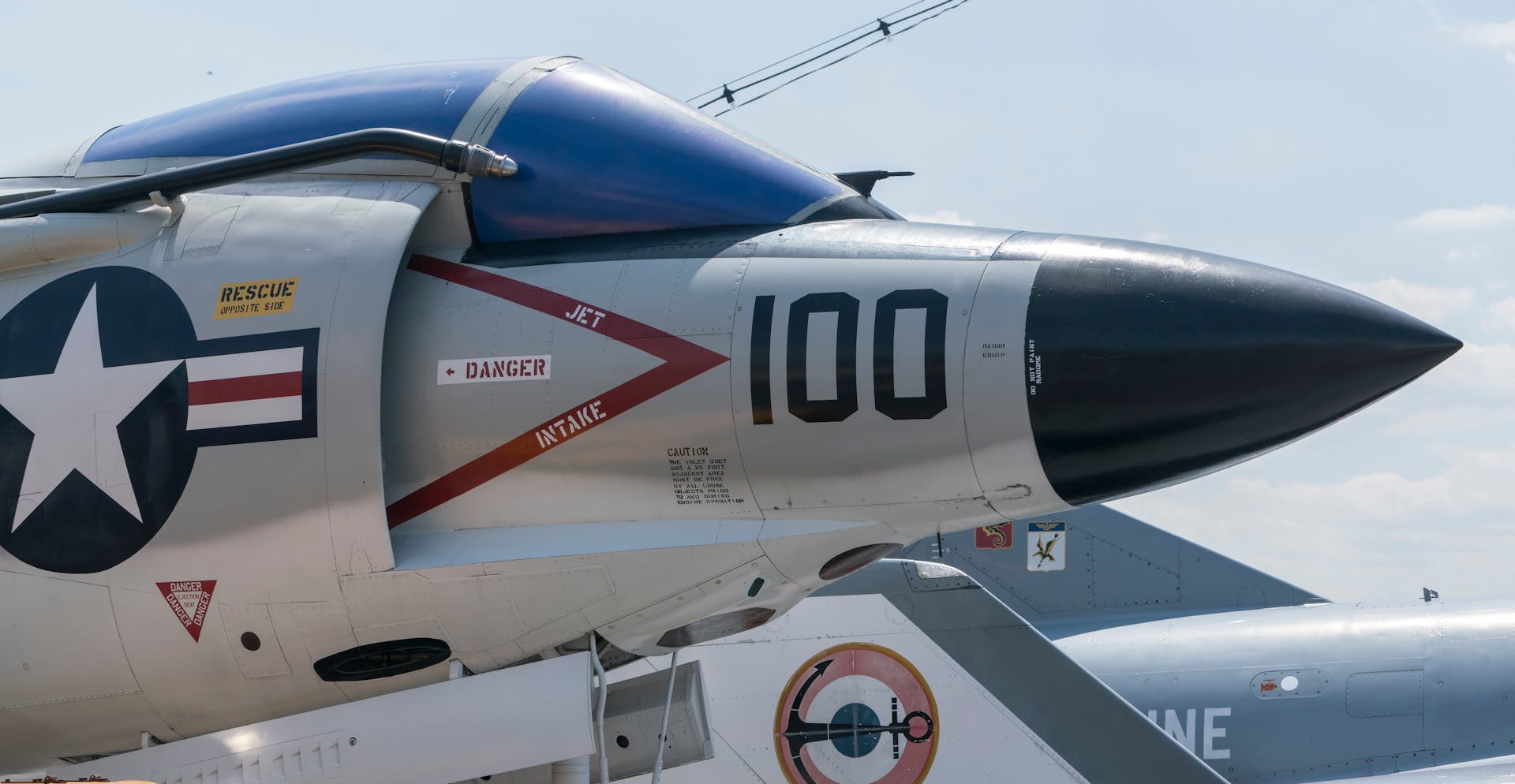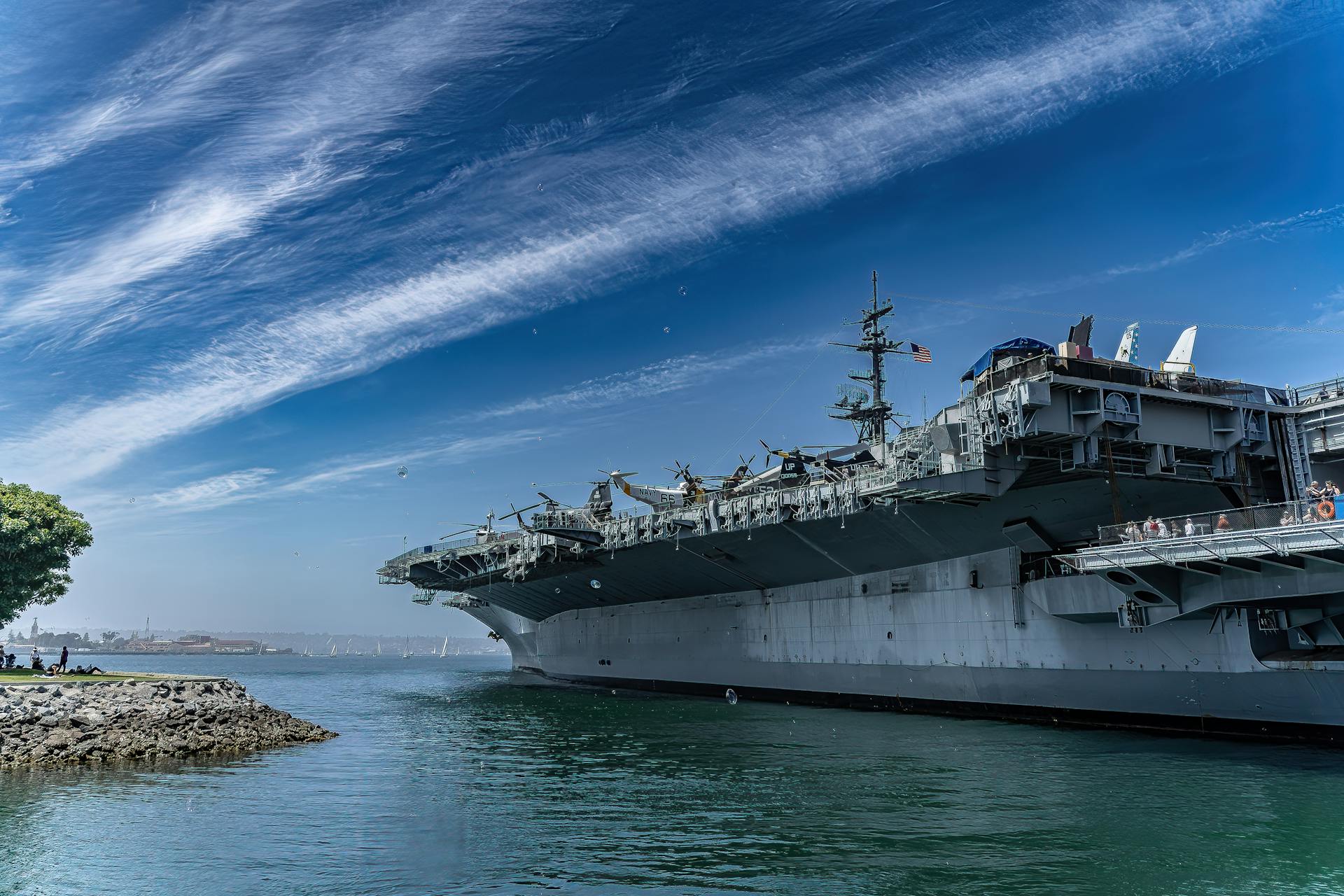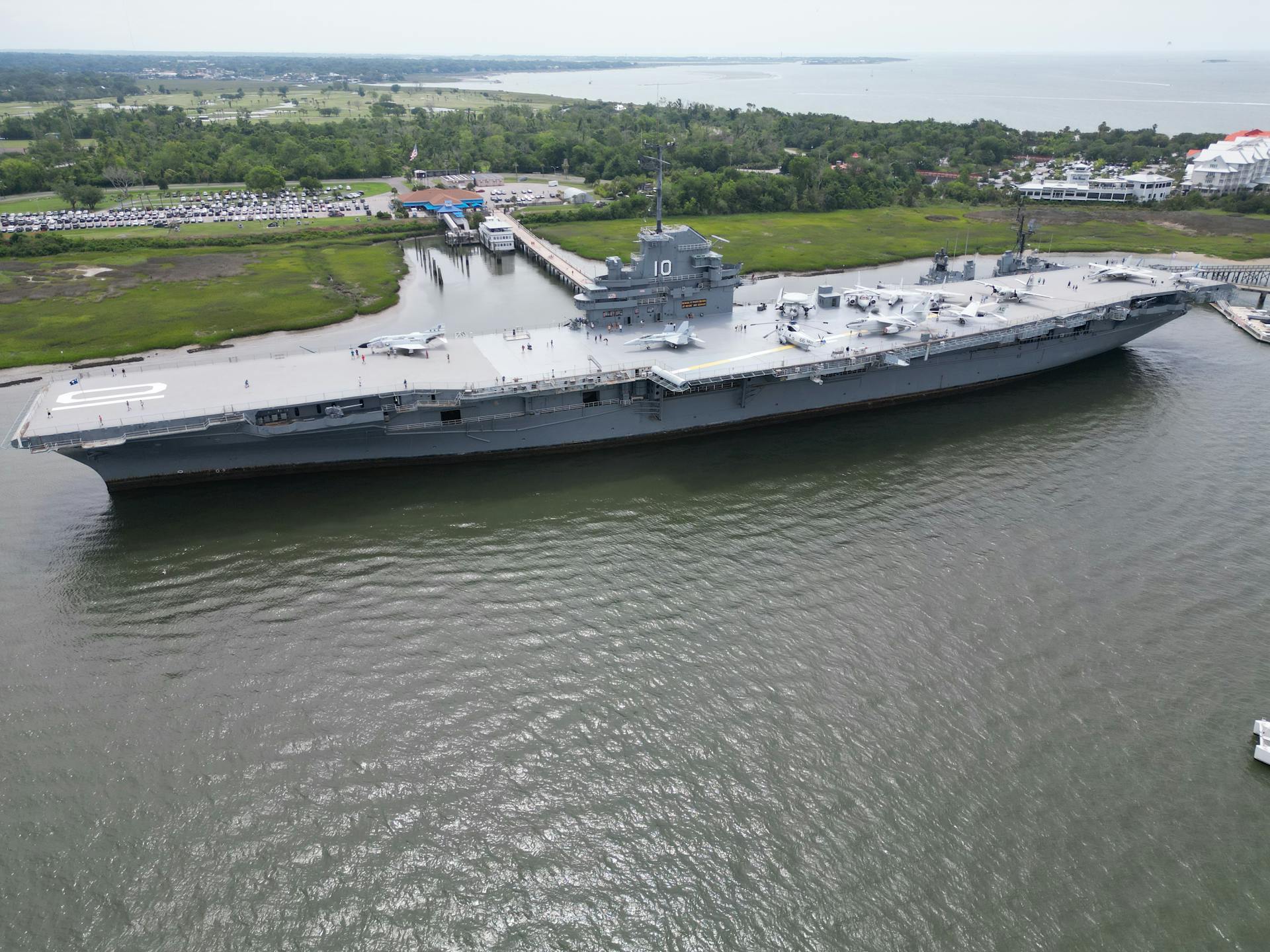
The USS Blue Ridge, a command ship with a rich history, has been serving the US Navy since 1971. Commissioned on November 8, 1971, it was built at the Newport News Shipbuilding company.
The Blue Ridge was initially classified as a command ship, and its primary role was to serve as the flagship for the US Seventh Fleet. This marked a significant shift in the Navy's strategy, as command ships like the Blue Ridge allowed for more flexible and adaptable command structures.
As a command ship, the Blue Ridge was equipped with advanced communication systems and a large crew to support its duties. Its crew of around 1,200 personnel was responsible for operating and maintaining the ship's complex systems.
The Blue Ridge has undergone several upgrades and renovations over the years, including a major overhaul in 1999 that updated its communication and navigation systems.
History
USS Blue Ridge (LCC-19) was commissioned on November 14, 1970, at the Philadelphia Naval Shipyard as an Amphibious Command and Control (LCC) ship.
The ship's commanding officer at the time was Captain Kent J. Carroll, and it was sponsored by Mrs. Gretchen Byrd, wife of U.S. Senator Harry F. Byrd Jr.
The principal speaker at the ceremony was John W. Warner, Under Secretary of the Navy and later Senator from Virginia.
Blue Ridge was designed from the keel up as a command and control ship, with advanced computer systems, extensive communications packages, and modern surveillance and detection systems.
It was the lead ship of its class and represented almost seven years of planning and construction work.
Blue Ridge was the replacement for USS Estes, which was decommissioned earlier than planned in October 1969 due to budget cuts.
The ship was initially armed with two twin Mark 33 3"/50 caliber guns, two Mark 25 launchers, and electronics for the Basic Point Defense Missile System (BPDMS).
Here are some key specs of the USS Blue Ridge:
The USS Blue Ridge has a top speed of 23 knots and a full displacement of 19,177 tons.
WestPac Deployments
USS Blue Ridge (LCC-19) made several deployments to the WestPac region, with the first one taking place in February 1972.
Blue Ridge departed San Diego and steamed to Pearl Harbor for deployment on her first WestPac, with port visits at Guam, Sasebo, Japan, White Beach, Okinawa, Subic Bay, Hong Kong, and Singapore.
The ship performed her second crossing of the equator on 27 February 1972, bound for Singapore, and became the flagship for Commander Amphibious Group 1.
Blue Ridge spent 64 days at sea during the Easter Counter-Offensive, from 5 April to 7 June 1972, the longest time at sea during her first WestPac deployment.
The ship earned the Republic of Vietnam Campaign Medal on 1 July 1972, during her first WestPac deployment.
Blue Ridge's second WestPac deployment took place from 12 February 1973 until 4 April 1973, and she contributed to Operation Homecoming, returning POWs from Hanoi and VC camps in South Vietnam to Clark Air Base in the Philippines.
During this deployment, Blue Ridge conducted training exercises, including Operation Golden Dragon off South Korea and Operation Pagasa I off the Philippines.
Blue Ridge's third WestPac deployment was disrupted by the deteriorating military and political situation in Cambodia and South Vietnam, but the ship participated in several campaigns.
You might like: SS South American
1971
In 1971, Blue Ridge conducted her first INSURV in the North Atlantic, after transiting the Delaware River, from and return to Philadelphia.
The ship's maiden voyage began on 11 February 1971, steaming from the shipyard to San Diego, California, around South America via the Strait of Magellan, making liberty calls at various ports.
Blue Ridge's beam is 108 feet, but the Panama Canal locks at that time were only 110 feet, creating problems for the ship with fenders and barges for the sponsons.
As the ship crossed the equator on 26 February, bound for Rio de Janeiro, Blue Ridge performed her first crossing the line ceremony, initiating the "wog" majority of the crew, except for one.
The Chilean patrol boat lost its mast and damaged one of Blue Ridge's basket antennas during a boarding operation in the Strait of Magellan.
Blue Ridge arrived at San Diego on 9 April, with Rear Admiral David M. Rubel, U.S. Navy, Commander Amphibious Group Three and staff embarked.
A fresh viewpoint: BRP Diego Silang (FFG-07)
The rest of the year was highlighted by Command Post Exercises 3–7 May and 11–13 August, and refresher training was conducted in late June and early July.
Blue Ridge acted as amphibious task force and landing force flagship for the major amphibious training exercise of the year, ROPEVAL WESTCO (3-71), from 8–16 September.
For Blue Ridge's first drydock since the Philadelphia Naval Shipyard, she was in the Long Beach Naval Shipyard from 11 October to 19 November for Post Shakedown availability.
You might like: Vitters Shipyard
February - WestPac I
Blue Ridge departed home port San Diego on 7 January 1972, after completing degaussing in the deperming facility at Ballast Point.
The ship steamed to Pearl Harbor for deployment on its first WestPac, with port visits at Guam, Sasebo, Japan, White Beach, Okinawa, Subic Bay, Hong Kong, and Singapore.
Four Soviet reconnaissance aircraft overflew the convoy to collect data on the new ship during the transit to WestPac, Guam, with USS Sterett and USS Mahan.
Readers also liked: USS Guam (LPH-9)

Blue Ridge performed her second crossing the line ceremony on 27 February 1972, as the ship crossed the equator at 0°00′N105°14′E / 0°N 105.24°E / 0; 105.24.
Upon arrival at White Beach, Blue Ridge became the flagship for Commander Amphibious Group 1, Rear Admiral W. D. TOOLE, relieving USS Paul Revere (LPA-248).
WestPac II
Blue Ridge departed San Diego on 24 February 1973 for her second WestPac deployment.
She made liberty port visits to Sasebo, Yokosuka, White Beach, Hong Kong, Subic, Manila, Singapore, and Chilung.
Blue Ridge conducted training exercises, including Operation Golden Dragon off South Korea and Operation Pagasa I off the Philippines.
On 10 July 1973, she left White Beach headed for the Gulf of Tonkin, carrying equipment needed by U.S. helicopters involved in clearing mined North Vietnamese waters.
Blue Ridge spent two nights in north Vietnamese waters off the coast of Vinh and Hon Matt before departing for Manila in the Philippines.
You might like: List of White Star Line Ships
The ship was conducting a joint exercise with the Philippine Navy in the South China Sea called PAGASA II, as the command ship, when one of her ensigns went overboard unnoticed on 28 September 1973.
A search and rescue operation commenced without success, and two days later the ensign was declared missing at sea.
A dramatic turn of events occurred when the Soviet trawler AGI Kursograph found the American sailor in Blue Ridge's operation area, and after diplomatic negotiations, the ensign was returned safely to Blue Ridge on 2 October 1973.
Westpac III
In WestPac III, the USS Blue Ridge's plans were disrupted by the deteriorating situation in Cambodia and South Vietnam.
Late in March 1975, the military and political situation in the region was a major concern.
The USS Blue Ridge had previously experienced disruptions in its operational plans in late March 1972.
This was a challenging time for the crew, who had to adapt to changing circumstances.
Arab Oil Embargo
The Arab Oil Embargo of 1973 had a significant impact on the USS Blue Ridge. During this time, the ship became the first Seventh Fleet combatant ship to refuel at sea with a commercial tanker.
In October 1973, Blue Ridge refueled with the Falcon Princess, taking on 158,000 gallons of Navy distillate. This was a crucial operation, given the disruptions caused by the oil embargo.
As a result of the embargo, Blue Ridge had to adjust its operations, including a joint exercise with the Philippine Navy in the South China Sea called PAGASA II.
1990s and Beyond
The 1990s were a significant decade for USS Blue Ridge. Blue Ridge performed a nine-and-a-half–month deployment as flagship for commander, United States Naval Forces Central Command (ComUSNavCent), during Operations Desert Shield, and Desert Storm from 28 August 1990 through 24 April 1991.
This deployment earned Blue Ridge a Navy Unit Commendation. The crew's hard work and dedication were recognized with this prestigious award.
In July 1996, Blue Ridge visited Vladivostok for the 300th Anniversary of the Russian Navy, marking a significant diplomatic and cultural exchange.
1972

In 1972, Blue Ridge deployed to the Western Pacific on 6 WestPacs as the flagship of the Commander Amphibious Force, Seventh Fleet.
The deployment marked a significant milestone in Blue Ridge's history, showcasing its capabilities and versatility in the region.
By the end of the decade, Blue Ridge had solidified its presence in the Western Pacific, cementing its reputation as a reliable and capable vessel.
Curious to learn more? Check out: Ghost Ship of the Pacific
The 1990s
The 1990s were a pivotal time for Blue Ridge, marked by a significant deployment from August 1990 through April 1991. During this period, Blue Ridge served as the flagship for commander, United States Naval Forces Central Command, and received a Navy Unit Commendation.
Blue Ridge played a key role in Operations Desert Shield and Desert Storm, showcasing its capabilities in a high-pressure environment. The experience likely honed the crew's skills and prepared them for future challenges.
In July 1996, Blue Ridge made a notable visit to Vladivostok, Russia, to celebrate the 300th Anniversary of the Russian Navy. This diplomatic gesture highlights Blue Ridge's ability to engage with international partners.
Blue Ridge continued to participate in routine training exercises throughout the 1990s and beyond, solidifying its position as a vital component of the US Navy's presence in the Western Pacific and Indian Ocean.
Awards

USS Blue Ridge (LCC-19) earned the Combat Action Ribbon for her action at Tiger Island on 18 July 1972.
The ship received the Battle Effectiveness Award (Battle "E") on 9 August 1972, for her outstanding performance in Vietnam operations.
She was awarded the Meritorious Unit Commendation and Navy Unit Commendation for her role in Operation Frequent Wind, the helicopter evacuation of Saigon in April 1975.
USS Blue Ridge also earned the Joint Meritorious Unit Award and the Humanitarian Service Medal during Operation TOMODACHI.
Here are some of the notable campaigns USS Blue Ridge was a part of:
Frequently Asked Questions
Where is the USS Blue Ridge LCC 19?
The USS Blue Ridge LCC 19 is forward deployed in Yokosuka, Japan, a large naval facility located 45 miles southwest of Tokyo.
What does LCC stand for in the Navy?
LCC stands for Large Command Craft, a type of special-purpose ship in the United States Navy designed for commanding large amphibious invasions.
What is the oldest Navy ship still in use?
The USS Constitution is the oldest commissioned ship in the United States Navy, still actively serving with naval officers and crew on board. It's a historic gem where visitors can experience cannon fire daily and learn more about its rich history.
What does the USS Blue Ridge do?
The USS Blue Ridge is a command and control ship designed to support the staff of amphibious task forces and landing forces. It serves as a mobile headquarters for senior military leaders.
Sources
- https://en.wikipedia.org/wiki/USS_Blue_Ridge_(LCC-19)
- https://www.navsource.org/archives/10/01/0119.htm
- https://www.dvidshub.net/unit/LCC-19
- https://www.navysite.de/ships/lcc19.htm
- https://military-history.fandom.com/wiki/USS_Blue_Ridge_(LCC-19)
- https://www.deagel.com/Navies/LCC%2019%20Blue%20Ridge/a000101
Featured Images: pexels.com


